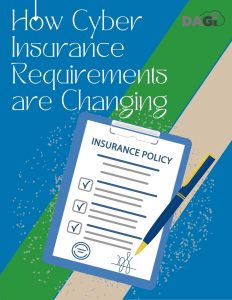 If you’ve renewed your cyber insurance policy in the last year, you’ve probably noticed the forms are getting longer, the questions are getting tougher, and the fine print feels more like a legal textbook.
If you’ve renewed your cyber insurance policy in the last year, you’ve probably noticed the forms are getting longer, the questions are getting tougher, and the fine print feels more like a legal textbook.
That’s not your imagination — it’s the new reality.
Cyber insurers have seen claim payouts skyrocket due to ransomware, phishing, and data breaches. In response, they’re tightening requirements and raising the bar on what counts as “reasonable” protection.
For Ontario small and mid-sized businesses, this shift isn’t just about insurance. It’s about rethinking your IT strategy to meet these new demands — and making sure your coverage actually works when you need it.
Why Cyber Insurance Is Changing
A few years ago, cyber insurance was like an optional add-on — something you bought for peace of mind. Requirements were minimal, and you could often get coverage without much scrutiny.
But then came the ransomware surge. Between 2020 and 2023, claims skyrocketed. Insurers paid out millions — in some cases, more than they collected in premiums.
By 2024, insurers realized they couldn’t just absorb the losses. The result? Stricter eligibility rules, more detailed questionnaires, and higher premiums for businesses without strong cybersecurity in place.
The New “Must-Haves” for 2025
While every insurer’s checklist is a little different, several requirements are becoming standard:
Multi-Factor Authentication (MFA):
Required for all email accounts, admin logins, and remote access.
Without MFA, many insurers won’t even issue a policy.
Endpoint Detection & Response (EDR):
Advanced antivirus that monitors for suspicious activity and can isolate infected devices.
Regular, Tested Backups:
Offsite or cloud backups that are immutable (read-only) and tested at least quarterly.
Email Filtering & Phishing Protection:
Systems that scan for malicious links, attachments, and suspicious sender behaviour.
Security Awareness Training:
Documented training for all employees, often required annually or semi-annually.
Incident Response Plan:
A written, tested plan outlining how your business will respond to a breach.
Why This Matters for Your IT
Here’s the hard truth: Insurance is no longer a substitute for security.
It used to be that a payout could help cover the cost of recovery after an attack. Now, without these controls in place, your claim could be denied entirely.
This means IT isn’t just “keeping the computers running” anymore — it’s directly tied to whether you’re insurable and whether your business can recover financially after a cyber incident.
The Cost of Non-Compliance
If you fail to meet your insurer’s requirements:
You could lose coverage. Renewal applications are now reviewed in detail, and insurers may drop clients who don’t meet their standards.
Your premiums could skyrocket. Weak security means higher risk — and higher rates.
Claims could be denied. If a breach occurs and you can’t prove you had the required controls in place, you may be on your own financially.
Real-World Example: The Denied Claim
The City of Hamilton suffered a ransomware attack in early 2024. They had cyber insurance, but their policy required MFA for all accounts. While MFA was enabled for admin logins, it wasn’t rolled out to all departments.
When they filed the claim, the insurer pointed to that gap — and denied payment. The City faced $18.4 million in recovery costs out of pocket with an additional $400,00 per month.
See our previous blog post about the City of Hamilton: City of Hamilton Breach
How to Prepare for the New Cyber Insurance Landscape
- Review Your Current Policy
Don’t wait until renewal. Read the fine print now, and make note of every security requirement.
- Treat the Questionnaire Like an Audit
When you fill out your insurer’s questionnaire, be accurate. Guessing or stretching the truth can void your coverage if there’s a claim.
- Close the Gaps
If your insurer requires MFA, EDR, and backup testing, get those in place now — not two weeks before your policy renewal.
- Document Everything
Keep records of:
- MFA deployment dates
- Backup test results
- Employee training logs
- Incident response plan updates
- Documentation can make the difference between a paid claim and a denied one.
- Partner With a Proactive MSP
A Managed Service Provider can set up the security stack your insurer expects, handle ongoing monitoring, and produce the reports you’ll need for compliance.
The MSP Advantage in Meeting Insurance Requirements
Working with a proactive MSP means:
- Baseline security from day one — MFA, EDR, backup testing, and email filtering included.
- Ongoing proof — monthly reports that show your security controls are active and working.
- Guided renewals — help completing insurance questionnaires accurately and confidently.
- Incident readiness — an incident response plan that’s tested, updated, and ready to execute.
The Bottom Line
Cyber insurance is still a smart investment. But it’s no longer a “set it and forget it” safety net. The requirements are getting tougher, and they’re not going away.
For Southwestern Ontario businesses, the smartest move is to treat those requirements not as hoops to jump through, but as a roadmap for better security.
By putting these protections in place now, you’re not just securing coverage — you’re reducing the chance you’ll ever need to make a claim in the first place.
Contact us for a free cyber security audit: https://www.dagi.ca/initial-consult-meeting-15-minutes/






